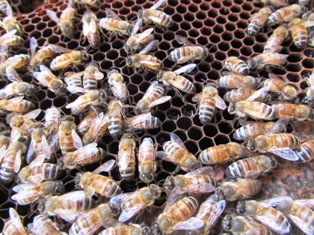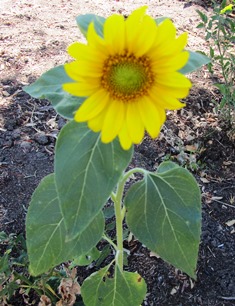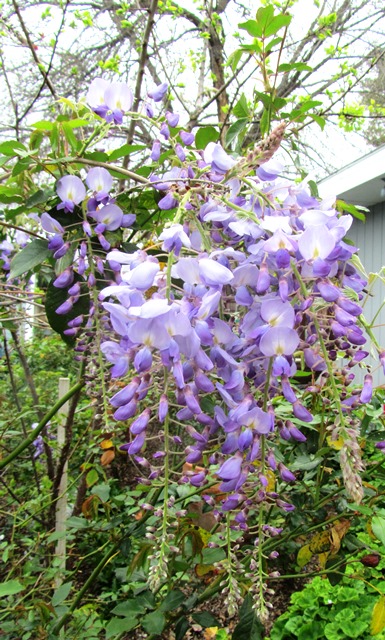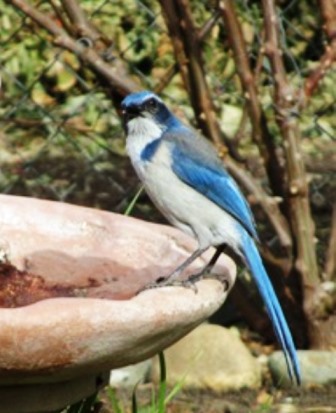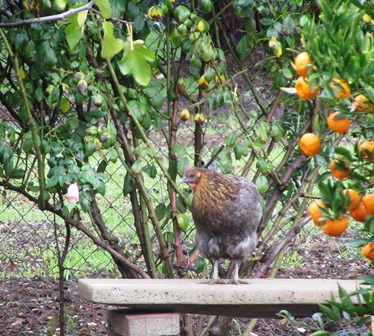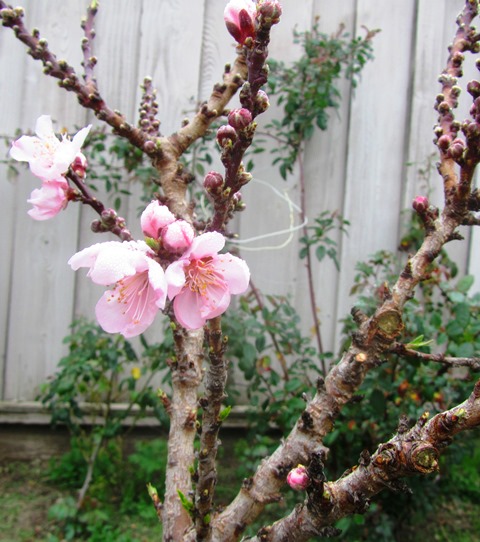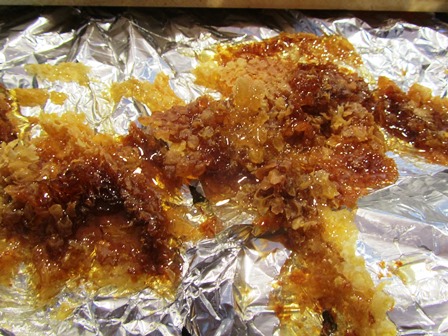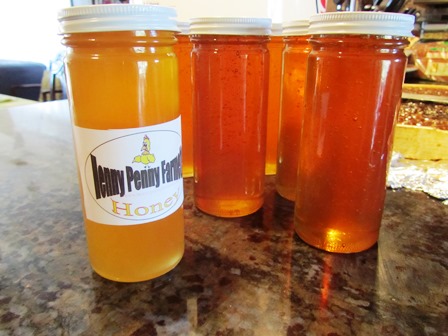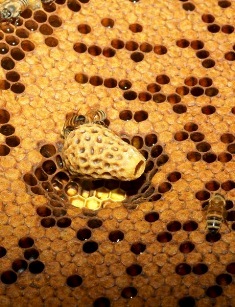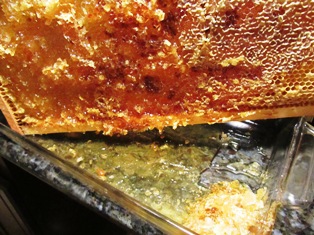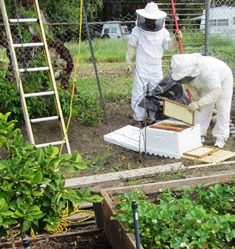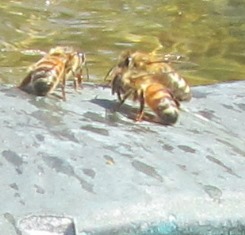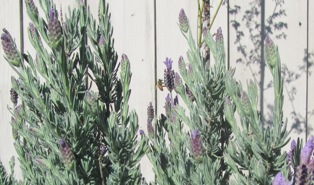Archive for the 'Honeybees' Category
An Heirloom Selection of Old Varieties of Flowers
Mid-March to early April on the farmette brings the celebration of birthdays and the promise of new selections of flowers for our spring gardens. This year, our new plants are old varieties.
A fellow-gardener friend gave me a selection of antique flowers for pollinators that included Bee Balm, Sweet Alyssum, Prickly Poppy, Sunflowers, and Kiss-Me-Over-The-Garden-Gate. These will go in various flower beds around our property.
Pollinators include many species of bees. We want them in our gardens to pollinate our fruits, vegetables, berries, and nut crops. Planting open-pollinated flowers enable pollinators to forage for pollen and nectar (their sources of food). When we provide rich food sources for pollinators, our food crops will benefit.
At a time when bee populations are declining worldwide, gardeners everywhere can help the besieged bees by planting diverse, open-pollinated varieties of pollen- and nectar-rich flowers. The following flower selection are considered old garden mainstays.
Bee Balm–“Bergamo” Monarda hybrida
This perennial likes sun to light shade and soil that is moist, and well-drained. The plant will reach two feet tall and will bloom summer to fall. It attracts both hummingbirds and bees.
Sweet Alyssum–“Benthalmii” Lobularia maritima
Alyssum is an annual that likes full sun but part shade in the hottest areas of hte garden. Soil preferences is rich, moist, and well-drained. It reaches a height of ten inches and small white blooms form summer to fall. It will flower repeatedly if it is clipped back after flowering.
Prickly Poppy–“Busy Bee” Argemone platyceras
A sun lover like all poppies, this one is an annual that loves poor, dry, gravelly soil. It will grow to three feet and bloom throughout the summer into fall. It does have prickly spines, so care must be taken to avoid contact with the spines.
Sunflowers–“Pan,” Helianthus debilis, subspecies: cucumerifolius
Another sun lover, this annual thrives in rich, well-drained soil. Plants will reach three feet in height and bloom summer through the fall. These sunflowers make excellent cut flowers.
Kiss-Me-Over-The-Garden-Gate–” Polylgonum orientale
This annual will go at the back of the garden since it reaches a height of six to seven feet. It likes well-drained, moist, rich soil that is located in full sun. The plants bloom summer throughout the fall and self-sows.
Flowers, Nest-Building, and Bee Swarms . . . Spring Has Arrived
The wisteria hangs in long purple bracts, its color finding resonance in the grape hyacinth blooms and the lavender buds. Delicate blossoms of pink and white create canopies of color for the fruit trees, and birdsong fills the air. Spring brings its gifts.
As the blue jay creates a screeching racket to the mockingbird’s ready song, the white-crowned sparrows have taken up residence in a row of birdhouses we’ve placed high on the back fence.The entrances of the sparrow houses are too small for the jay to access; a good thing since jays have earned a reputation as nest robbers.
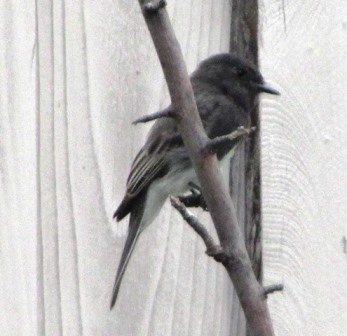
Crew Cut, our resident black phoebe, nests under an eve of the old chicken house; the male teaches its young to catch insects on the wing
Yesterday, I spotted the black phoebe pulling a piece of coir from a wall planter for its nest. These peaceful birds make a sound of tsip or fi-bee, fi-bee and can rise to roughly 50 feet to sing to a female.They range from California to central Texas, and even venture all the way to Argentina.
In the tallest eucalyptus on the acre that stands vacant behind our property, a pair of hawks are also nest-building. My farmette lies in their flight path. Not a good thing to see–hawks swooping down over my chickens and then rising to their lofty nest.
I threw some wildflower seed in beds over the weekend and then, after spotting my neighbor’s errant hen who flew to our yard, I began to regret my action. What can I do now but hope that she’ll not devour the seeds with her constant hunting and pecking?
Last night, I could have sworn I heard the pitter-patter of raindrops against the stone patio floor. With a steaming mug of coffee in hand at four o’clock this morning, I ventured outside and sure enough . . . it was still sprinkling. Hooray! It’s our first spring shower!
So, with all the nest-building and Mother Nature dropping a shower upon us, I know the wildflowers are blooming, too. That means the honeybee season is upon us. My neighbor has already had a bee swarm. I’m not ready, but I can’t stop Mother Nature from beginning a new cycle of seasons just because I don’t yet have my new honey frames assembled. That’s not how it works. Ready or not, spring has arrived.
Blooms over the Garden Gate
The nectarine trees are susceptible to Peach Leaf Curl and usually, I try to spray them three times before the next year’s blooms. Alas, this year, I didn’t complete the task before the tree broke bud.
Elsewhere, the almonds, apricots, and apples are blooming. So are some of the roses–Lady Banks, for example. Also, Fiesta and the beautiful Iceberg rose in the front of our house.
My neighbor’s two almond trees are covered in blooms of white blossoms. Last Friday, when I contacted a local beekeeper business, I was told they were closed to move their hives of bees out to pollinate the almond orchards. Farmers pay the beekeepers for “renting” those hives of industrious little bees for the job of pollinating their crops.
This is supposedly “bare root” season, but the warm weather coupled with the rain we had in December seems to have brought us an early spring. If you look over my garden gate, you will see signs of it everywhere.
Working the Beds after the Weekend Storm
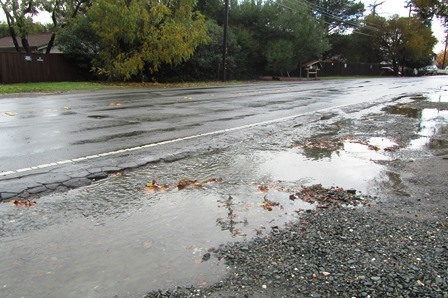
A “Pineapple Express” rainstorm with gale-force winds blew out the power and made for slick roads as well as ponds in our clay soil
The weekend storm is still a vivid memory, what with the fence along one side of my property beaten down by high winds and pounding rain that also brought a power outage on Friday night.
But today with outside temperatures in the 70s Fahrenheit, I cleaned my strawberry beds. Somehow, mint had crept in and I don’t want mint with my berries although I like it served that way for dessert.
My neighbor’s relative, who’s visiting from Lebanon where they grow apples in his mountain village, share a suggestion for digging dried chicken manure around the bases of my trees. The high nitrogen will get them off to a great start and my trees have already broken bud (which is attracting the honeybees).
The wild bird population seems to have exploded and I see signs of nest building starting. The five suet cakes I hung in trees for the songbirds, blue jays, and woodpeckers last month are down to a fraction of their original size.
I extended the chicken run with poultry wire high enough to keep the my heritage girls from flying out. Now, they’ll have plenty of space on both sides of the chicken house to forage and out the beds I’m working.
Uncapping, Draining, and Straining a Frame of Honey
I have frames of honey wrapped in foil in my kitchen freezer. These frames haven’t yet been uncapped, drained, and strained for bottling.
Since the weather on the farmette has turned springlike, I can’t put this chore off any longer. Those frames have to come out of the freezer. They’re from late October. I’d wrapped them in aluminum foil and froze them until I could find time to work with them.
Once a frame had defrosted, I needed to open the cells of wax, capped by the bees. Opening capped cells becomes easier if you use a hot knife. I run mine through a gas burner and wipe frequently. After the cells are opened on both sides of the frame, I stand the rectangular wooden frame in a freshly washed two- or five-gallon bucket and cover the bucket with plastic wrap until the honey drains out.
Then, of course, the honey collected needs to be filtered. I use a bucket over which I’ve secured a thin painter’s net for straining paint. As the honey drains through, I twist around a large wooden spoon to tighten. Eventually, all that is left in the net strainer are pieces of wax. Many backyard beekeepers run honey through the straining process twice before bottling.
Using a coat hanger, I hang the frames (from which I harvested the honey) in a tree near the apiary. The bees will do the work of removing all traces of honey, leaving only wax. At this point, I’ll freeze the frames before reusing them.
This is a very old fashion way of harvesting honey. There are modern appliances and other tools, including an electric hot knife and honey extractor machines, that serious beekeepers can use. But the old ways, although more laborious, still work.
Time to Open the Hives, Check on the Bees
My honeybees have become surprisingly active for the dead of winter. Local forecasters tell us that the Bay Area temperatures may reach 80 degrees Fahrenheit by the end of the week. My apple and early peaches won’t wait; they’ve already blossomed.
The warm weather, time of year together with the fact that almond trees will be blooming in a couple of weeks and the lavender around my farmette is already blooming tells me I have to open the hives. My beekeeper neighbor says that his bees are already out collecting pollen–lots of it–and that means we have to get to work.
The hives have to be checked now for mold (that long period of hard rain in December caused some of my neighbor’s frames to mold). Moldy frames can’t be renewed; they have to be tossed. Honeybees can get nosema (with diarrhea), which shows up as spots at the base of the hive.
The bees are finding flowers on their forage runs and are returning to the hive laden with pollen.
Bee queens will be busy laying eggs in the coming weeks, if they aren’t already. This is the time for beekeepers to purchase new queens. By the first week in April, it’s possible we could see swarming.
So here’s the plan. If the hives have a lot of honey, I’ll harvest some. Strange to be doing that in winter, but the hive will need space for brood. I’ll have to remove frames of honey and insert empty frames with wax (put in the freezer first for a period to kill any pest they might be harboring over).
I’ll put bee food patties in the open hives, so they’ll have plenty to eat (once I take some of their honey). My beekeeper neighbor tells me this will get the hive “heated up” for the queen to do what she does best–lay the eggs.
With so much activity, I’m confident that everything will turn out well, but you never know until you’ve inspected the interior of the hive and checked out everything, including the possibility of mold or the presence of pests or illness.
Mother Nature didn’t ask me, but I would have preferred she wait another month before removing her winter robes and dressing in spring florals. It just seems like now everything to do with the hives is on fast forward!
How My Real Life Informs My Art
Every story needs a setting, a world in which something happens. For my cozy mysteries, I didn’t set out to create a new world for my coterie of characters, I just appropriated details of the life I am living as a farmette dweller.
Daily chores on our Henny Penny Farmette provide plenty of fodder for my fictional stories. Our daily activities include chicken care, garden and orchard work, beekeeping, cooking and preservation of vegetables and fruits, renovating the antiquated farm house, fixing sheds, and building fences and retaining walls.
Stories need a sense of verisimilitude for readers to suspend disbelief and join the fictional journey. Drawing upon my real-life experiences, I can easily integrate my adventures in my books. And not only my activities, but also experiences of my architect husband who is ever-occupied with making our old house more liveable.
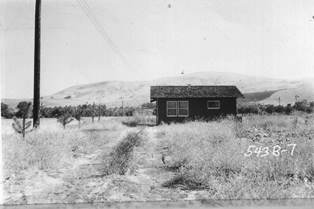
In this 1953 photo, our little house sat in a great, big field with not much around it; the dwelling faced Mount Diablo (still does) and the Delta and great central valley lie to the northeast
The tax assessor told me that our dwelling might have been a mining shack in the late 1940s (we live near Mt. Diablo and Lime Ridge where mining and rock quarrying were once important industries). We’ve also been told that our little house might have later served as a farm home (we live less than two miles from designated agricultural farmland). The structure desperately needed updating when we found it almost five years ago. But as settings go, the house and farmette work great.
We have since used recycled and reclaimed materials, sale items at big box DIY stores, and gifts (like lumber, stone, and windows/doors) from friends who do demolition on estates. We’ve visited companies that sell granite and asked for permission to take broken stone from their dumpsters. Thus, we’ve created a lovely bathroom floor with found materials that we’ve cut and sanded.

Light from a crystal chandelier dances off the new granite counter, but the floors were not yet installed when this photo was taken
Of course, the exact details of our daily activities may not make their way into my stories, but versions of them sometimes do. At the very least, such activities inform my storytelling. I daresay the chickens and bees serve important roles in my mysteries. And each new day brings new adventures, from foxes showing up to skunks and raccoons raiding our fruit and nut trees.
Lately, a new chicken showed up on our property (a heritage chicken that had the ability to fly over my neighbor’s fence). She’s been staying here ever since. Wild turkeys often take a path through the property and once or twice a gorgeous stallion named Romeo and its owner ride by and say hello. Such events can add textural details to the setting of a story.
Traits of Common Honeybee Strains
There are four main strains of domestic honeybees: Italian, Carniolan, Caucasian, and German Black. The bees in my backyard hives are of the Italian variety. They are gentle and co-exist with my chickens as well as tolerate visits from my daughter’s dogs who drop by to sniff around.
Italian, apis mellifera linguistica.
- Their coloring includes yellow pigmentation; the only honeybee with this coloring.
- They are gentle
- They don’t go great distances to forage
- They tend to produce honey stores in late summer and continuing foraging until late in the autumn to produce enough honey to get through the lean winter months
- They are not considered frequent swarmers
- They have a moderate spring buildup of the hive
- They may drift somewhat
Carniolan–apis mellifera carnica are honeybees that evolved on the European continent, particularly around Slovenia, Austria, Croatia, Serbia, Bosnia and Herzegovina.
- Carniolan honeybees are big and long in size like the Western European black bee.
- They possess a long tongue and high elbow joint
- They have pigmented dark spots in brown or gray and also have gray hairs
- They rapidly build up their numbers in the spring
- They are calm and gentle, not aggressive
- They swarm heavily
- They forage even under less than ideal conditions
- They may drift
Caucasian–-apis mellifera caucasica emerged in the Black Sea Caucus mountains and can be found today in Georgia, Turkey, Armenia, and Azerbaijan.
- Their color is mostly dark with some gray or brown spotting.
- They are gentle
- Slowly build their numbers in the spring
- Swarm less
- They produce lots of propolis (baby bee food)
- They tend to stop foraging and making honey stores early in the fall
- They winter over well except in northern climates where Nosema can be a problem
- They have a tendency to drift
German Black—apis mellifera mellifera was the first bee in America and still is prominent in feral populations but they are native to England and Germany.
- Their size is small
- Their pigmentation is dark
- They are not noted for gentleness
- They are susceptible to American foulbrood (AFB), one of the most dreaded diseases to affect honeybees
- They have survived in areas invaded by the aggressive Africanized bees
- They are well suited to northern climates
The Bee Garden Favorites
I spent Sunday building a rock circle around the circumference of our towering elm tree. I want to conserve water around the base of the tree and to also grow more plants for my bees to have abundant food.
We had a pile of river rock donated to us, so I thought it might look nice to create a wide circle, maybe three feet high around the tree like a watering basin/retaining wall, using the rock.
Inside the circle, I transplanted some yarrow and white geranium. Already, there are white roses that boom all summer long under the tree.
But bees like nectar-rich plants with pollen, so I’ve put together a list. Over the next week, I’ll add some of these in my new bed beneath the elm. This is a partial list of plants bees love.
- Rosemary
- Lavender
- Russian sage
- Basil (African blue)
- Honeywort
- Mexican Sunflower
- Borage
- Cerinthe
- Greek oregano
- Sweet marjoram
- Purple coneflower (echinacea)
- California poppies
- Lupine
- yarrow
- sunflowers
Eucalyptus on the property behind our farmette is not yet covered with fall bloom. The bees love that bloom but now they make do with the star thistle on the brown hillsides and by foraging on the French perfume lavender and the Spanish variety in my garden.
Of late, I’ve discovered the honeybees foraging on the sweet nectar at my hummingbird feeders, so I worry about them getting enough food. The drought has sapped everything. At any rate, I’ll hold off taking honey this fall, leaving it in the hives for the bees. They’ll need food to get through the rainy season.
Drought Hurts Honeybees, Too
The star thistle blooms in yellow bursts of color over the brown, drought-parched hills of the Bay Area during summer. Widely considered a noxious, invasive weed, the yellow star thistle’s blooms serve as a source of food for the honeybees during drought conditions when flower sources become scant.
While naturalists, government officials, land management people, ranchers, gardeners, farmers, and road and park maintenance workers consider the yellow star thistle challenging to control, others lament indigenous plants suffer or die because the yellow star thistle depletes the soil of moisture. Its one redeeming value appears to be as a food source for the bees.
Local beekeepers understand the value of the yellow star thistle during severe drought when water rationing in many counties mean few if any flowers are left blooming in August and September. While the plant’s nectar is great for the bees, it’s bad news for horses. Feeding on yellow star thistle over time can cause a horse malady known as chewing disease.
Also called St. Barnaby’s thistle and yellow cockspur, the yellow star thistle’s long tap root keeps it going while other plants around it die from lack of water. In Europe where the plant is indigenous, it is held in check by other plants that have co-evolved with it and by herbivores, the enemies of yellow star thistle. However, that’s not the case in the United States.
Since it was introduced to America in the early part of the 20th Century, the yellow star thistle has spread faster than a California wildfire and now covers some 15 million acres, just in this state alone. It is also considered a noxious, invasive weed in 35 other states. But the honeybees don’t care as long as there are enough of those yellow blooms to get them through the dog days of summer.
 Facebook
Facebook Goodreads
Goodreads LinkedIn
LinkedIn Meera Lester
Meera Lester Twitter
Twitter




